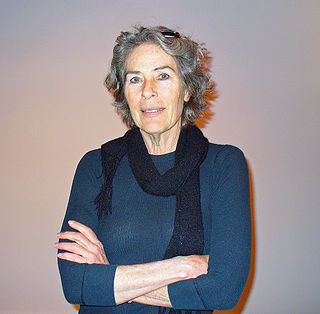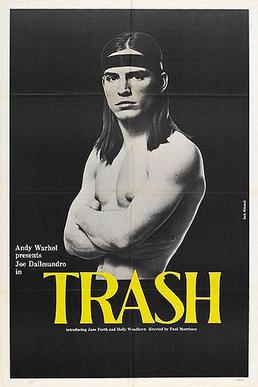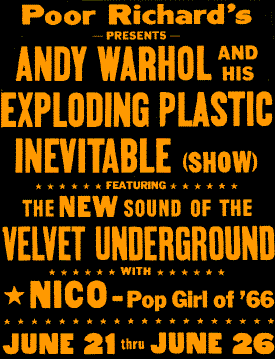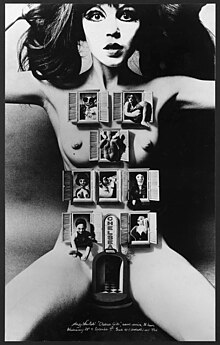
Andy Warhol was an American visual artist, film director, producer, and leading figure in the pop art movement. His works explore the relationship between artistic expression, advertising, and celebrity culture that flourished by the 1960s, and span a variety of media, including painting, silkscreening, photography, film, and sculpture. Some of his best-known works include the silkscreen paintings Campbell's Soup Cans (1962) and Marilyn Diptych (1962), the experimental films Empire (1964) and Chelsea Girls (1966), and the multimedia events known as the Exploding Plastic Inevitable (1966–67).

Edith Minturn Sedgwick Post was an American actress and fashion model who was one of Andy Warhol's superstars, starring in several of his short films during the 1960s. Her prominence led to her being dubbed an "It Girl", while Vogue magazine named her a "Youthquaker".
Brigid Emmett Berlin was an American artist and Warhol superstar.
Warhol superstars were a clique of New York City personalities promoted by the pop artist Andy Warhol during the 1960s and early 1970s. These personalities appeared in Warhol's artworks and accompanied him in his social life, epitomizing his dictum, "In the future everyone will be famous for fifteen minutes". Warhol would simply film them, and declare them "superstars".

The Factory was Andy Warhol's studio in New York City, which had four locations between 1963 and 1987. The Factory became famed for its parties in the 1960s. It was the hip hangout spot for artists, musicians, celebrities and Warhol's superstars. The original Factory was often referred to as the Silver Factory. In the studio, Warhol's workers would make silkscreens and lithographs under his direction.

Mary Woronov is an American actress, writer, and figurative painter. She is primarily known as a "cult star" because of her work with Andy Warhol and her roles in Roger Corman's cult films. Woronov has appeared in over 80 movies and on stage at Lincoln Center and off-Broadway productions as well as numerous times in mainstream American TV series, such as Charlie's Angels and Knight Rider. She frequently co-starred with friend Paul Bartel; the pair appeared in 17 films together, often playing a married couple.

Factory Girl is a 2006 American biographical film directed by George Hickenlooper. It is based on the rapid rise and fall of 1960s underground film star and socialite Edie Sedgwick, known for her association with the artist Andy Warhol.

Trash is a 1970 American drama film directed and written by Paul Morrissey and starring Joe Dallesandro, Holly Woodlawn and Jane Forth. Dallesandro had previously starred in several other Andy Warhol/Paul Morrissey films such as The Loves of Ondine, Lonesome Cowboys, San Diego Surf, and Flesh.

Lonesome Cowboys is a 1968 American Western film directed by Andy Warhol and written and produced by Paul Morrissey. The film is a satire of Hollywood Westerns, and was initially screened in November 1968 at the San Francisco International Film Festival, where it won the Best Film Award. On May 5, 1969, it was shown for initial viewings at the New Andy Warhol Garrick Theatre in New York City.
I, a Man is a 1967 American erotic drama film written, directed and filmed by Andy Warhol. It debuted at the Hudson Theatre in New York City on August 25, 1967. The film depicts the main character, played by Tom Baker, in a series of sexual encounters with eight women. Warhol created the movie as a response to the popular erotic Scandinavian film I, a Woman, which had opened in the United States in October 1966.

Vinyl is a 1965 American black-and-white film directed by Andy Warhol at The Factory. It is an early adaptation of Anthony Burgess' 1962 novel A Clockwork Orange, starring Gerard Malanga, Edie Sedgwick, Ondine, and Tosh Carillo, and featuring such songs as "Nowhere to Run" by Martha and the Vandellas, "Tired of Waiting for You" by The Kinks, "The Last Time" by The Rolling Stones and "Shout" by The Isley Brothers.

The Exploding Plastic Inevitable, sometimes simply called Plastic Inevitable or EPI, was a series of multimedia events organized by Andy Warhol in 1966 and 1967, featuring musical performances by The Velvet Underground and Nico, screenings of Warhol's films, and dancing and performances by regulars of Warhol's Factory, especially Mary Woronov and Gerard Malanga. Andy Warhol's Exploding Plastic Inevitable is also the title of an 18-minute film by Ronald Nameth with recordings from one week of performances of the shows which were filmed in Chicago, Illinois, in 1966. In December 1966 Warhol included a one-off magazine called The Plastic Exploding Inevitable as part of the Aspen No. 3 package.
Ronald Tavel was an American screenwriter, director, novelist, poet and actor, best known for his work with Andy Warhol and The Factory.

Susan Dunn Whittier Bottomly, also known as International Velvet, is a former American model and actress. She is known primarily for her appearances in many of Andy Warhol's underground films, as well as her modeling career which spanned over a decade.

Beautiful Darling: The Life and Times of Candy Darling, Andy Warhol Superstar is a 2010 feature-length documentary film about Candy Darling, pioneering trans woman, actress and Andy Warhol superstar. The film was written and directed by James Rasin and features Chloë Sevigny as "the voice of Candy Darling", reading from Candy's private diaries and letters. Patton Oswalt voices Andy Warhol and Truman Capote. It also features interviews with Factory regulars such as Paul Morrissey, Vincent Fremont, Bob Colacello, Gerard Malanga, Pat Hackett, George Abagnalo, and Fran Lebowitz as well as an archival interview with playwright Tennessee Williams. Louis Durra composed the score.
Four Stars is a 1967 avant-garde film by Andy Warhol, consisting of 25 hours of film. In typical Warhol fashion of the period, each reel of the film is 35 minutes long, or 1200 ft. in length, and is shot in sync-sound.
Since is a 1966 film directed by Andy Warhol about the assassination of the President of the United States, John F. Kennedy. The film reconstructs the assassination with both Kennedy and Lyndon B. Johnson present, both before and after the event. The roles in Since are performed by Warhol's "superstars" from The Factory.

My Hustler is a 1965 American film by Andy Warhol, and Paul Morrissey. The film is propelled by the sonorous, magnetic acting of 30-year-old Ed Hood interacting with the blonde Hustler, Paul America.

The Garrick Cinema was a 199-seat movie house at 152 Bleecker Street in the Greenwich Village neighborhood of Lower Manhattan in New York City. Andy Warhol debuted many of his notable films in this building in the late 1960s. Frank Zappa and the Mothers of Invention played here nightly for 6 months in 1967.

The 55th Street Playhouse—periodically referred to as the 55th Street Cinema and Europa Theatre—was a 253-seat movie house at 154 West 55th Street, Midtown Manhattan, New York City, that opened on May 20, 1927. Many classic art and foreign-language films, including those by Jean Cocteau, Sergei Eisenstein, Federico Fellini, Abel Gance, Fritz Lang, Josef Von Sternberg and Orson Welles, were featured at the theater. Later, Andy Warhol presented many of his notable films in this building in the late 1960s. Other notable films were also shown at the theater, including Boys in the Sand (1971) and Him (1974).
















